COVID-19 Outlook: Recovery from the Omicron Wave Has Started but Will Vary by Region

Data from our COVID-Lab forecasting model this week brings very welcome news: national COVID-19 case incidence should continue declining over the next four weeks. Hospital admissions have begun declining nationally as well, and given the forecasted declines in case incidence, we expect hospitalizations will continue declining in the coming weeks. There remains, as always, variation by region—thus, assessing your local data is important for determining appropriate mitigation measures.
Alongside clinical leadership at Children’s Hospital of Philadelphia (CHOP), we also released this week guidance for early care and education (ECE) settings, which you can read more about below. This guidance aligns with recommendations we recently provided for K-12 educational settings, and is intended to simplify the approach to practical COVID-19 mitigation measures across all of these settings.
Let’s first review hospitalization trends:
- Over the last week, national adult hospital admissions for COVID-19 fell more than 20% and pediatric admissions fell by nearly 40%.
- Fifteen states had fewer adult hospital admissions than the week prior—a trend led by states along the I-95 corridor between New York City and Washington, D.C. Delaware, for example, had nearly half as many admissions this week compared to the week prior.
- Ten states had declining pediatric hospital census compared to the week prior. Similar to the adult census data, these declines were concentrated in the Northeast and Mid-Atlantic, but also now include Georgia and Mississippi.
- Some states have seen a leveling off of their hospital censuses. These states include Illinois, Ohio, and Indiana, indicating the I-80 corridor is improving and is just a week behind the East Coast.
- Adult and pediatric admissions and hospitalizations increased last week in communities along the northern rim of the country, the lower Midwest and the Mountain West.
- Emergency department visits are now declining in all regions of the country, though declines in the West and Midwest have been slower than those in the Northeast and South.
Here are the national and regional updates for PCR positivity rates, reproduction numbers and case incidence:
- The national average PCR test positivity rate is 33%, relatively unchanged from last week’s rate of 31%. However, nearly 40% of the 812 counties we follow in our model had a declining test positivity rate, up from 12% last week. Major cities with substantial drops in testing positivity include Cleveland, New Orleans, Atlanta, Newark, NJ, Baltimore and Washington, D.C.
- The national average reproduction number (a measure of transmission that estimates how many additional individuals, on average, will be infected by every positive case) declined from 1.79 last week to 1.35 this week. Ninety-five percent of the counties we follow saw declining reproduction numbers this week, compared to only 60% of counties last week. This also included 20% of counties with reproduction numbers now under 1, indicating declining case incidence (up from only 5% the week before).
- Average county case incidence reached 1,500 weekly cases per 100,000 residents last week, up from nearly 1,200 weekly cases per 100,000 residents the week before.
- Our models forecast that national average case incidence will decline, and we project continued declines in most regions over the next four weeks. Look at our forecast for Los Angeles County, Calif., for example.
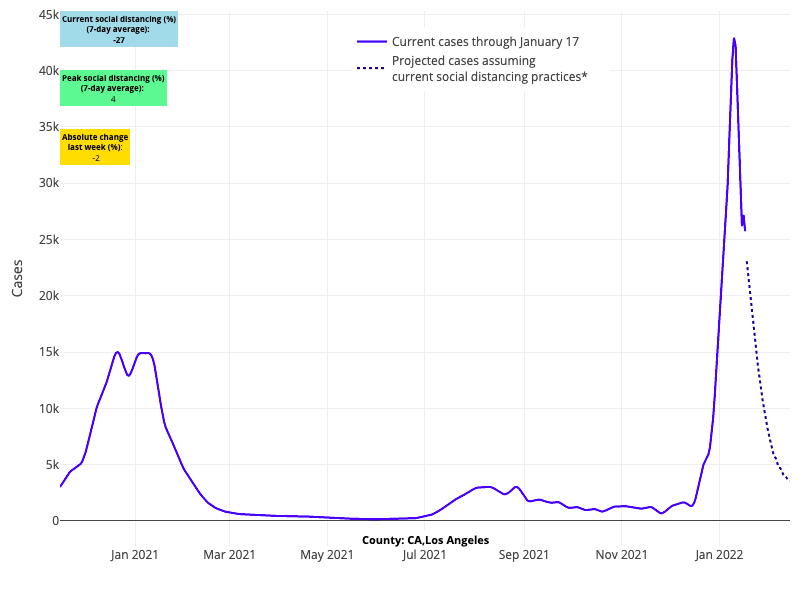
Above are the projections for Los Angeles County in California.
- Still, some areas have not yet peaked. For example, our case incidence projections for Portland, Ore., and Seattle suggest these cities’ recovery will be slower than areas to their south.
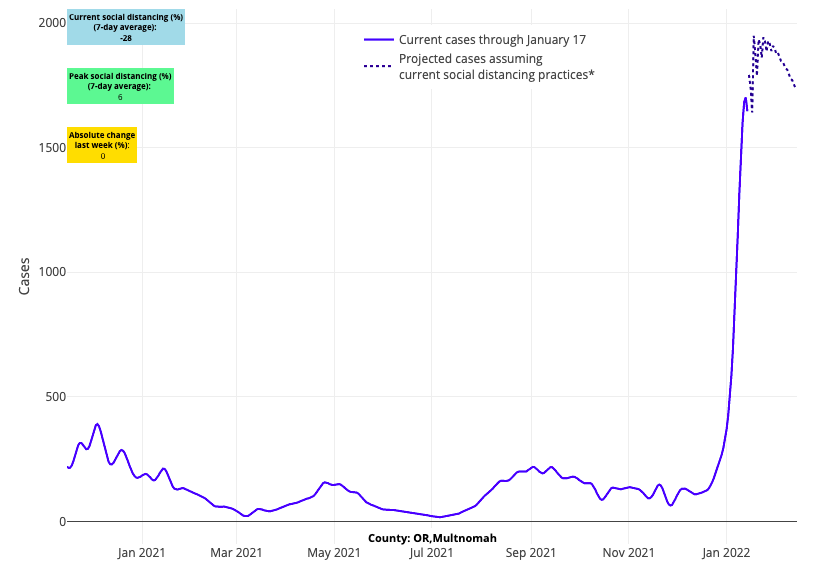
Above are the projections for Multnomah County in Oregon.
- The state of Texas is a tale of two halves: the northern region, which resembles the Heartland to the north, and lower Texas, which resembles the Southeast. Our forecasts for Austin and Houston predict quick recovery, while those for Dallas and other northern areas lag behind—a trend we also observed last winter.
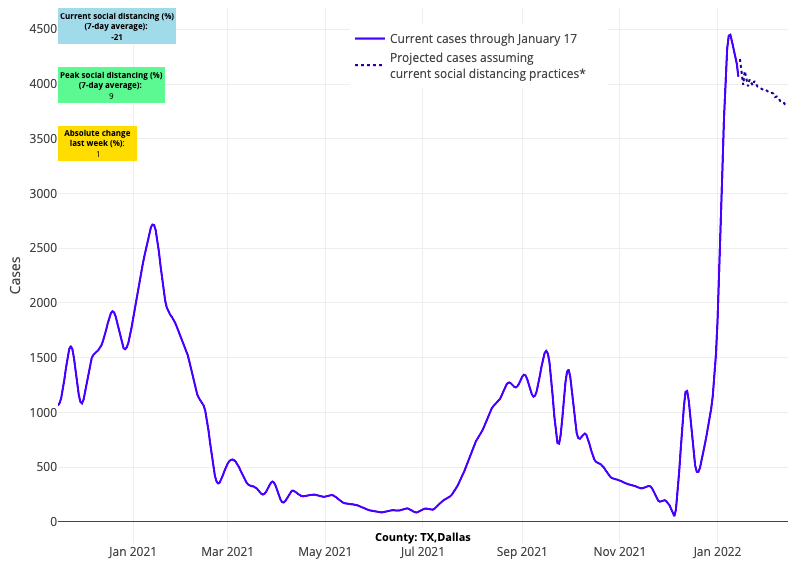
Above are the projections for Dallas County in Texas.
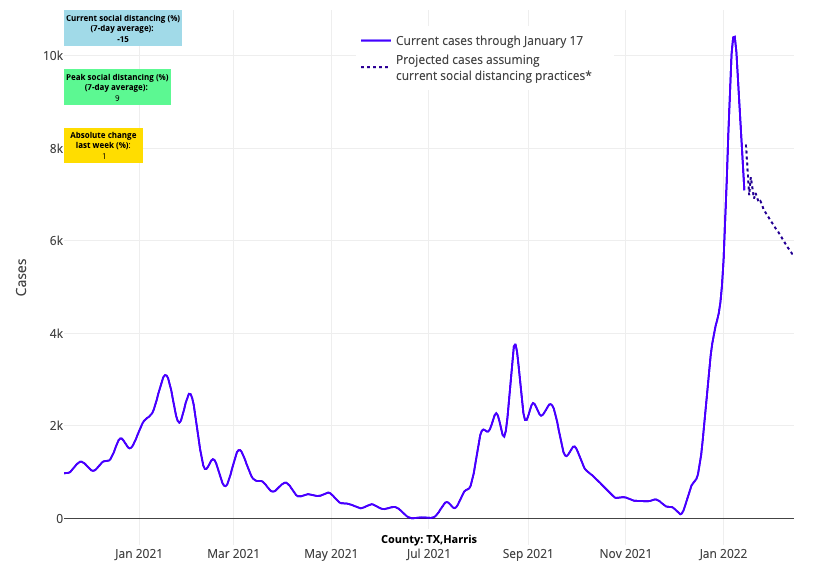
Above are the projections for Harris County (Houston) in Texas.
- Another area that has worsened over the last two weeks is the Mountain West, particularly Utah, Montana, Wyoming and Idaho. The ski season effect, which we saw last season too, means communities like Summit County, Utah, Eagle County, Colo., Canyon County, Idaho, and Gallatin County, Mont., are seeing resurgence that has not yet turned the corner.
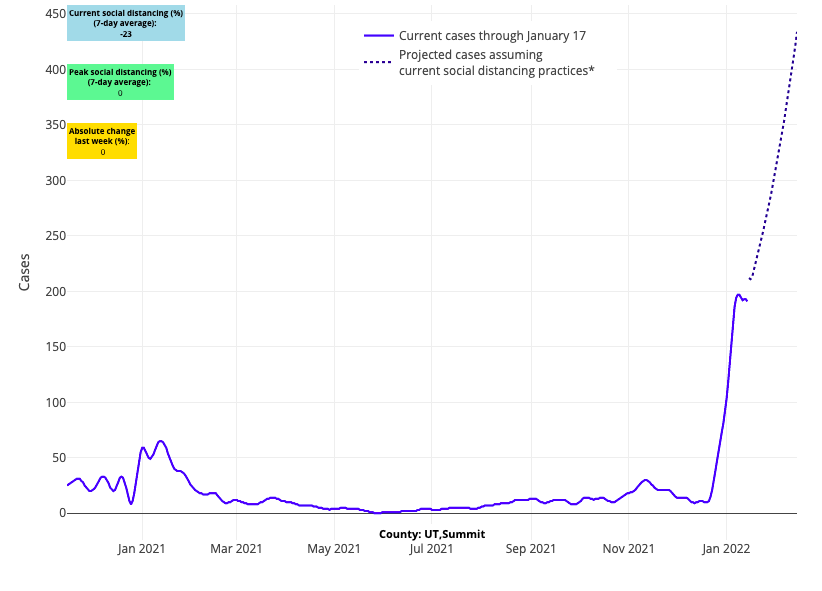
Above are the projections for Summit County in Utah.
Case incidence and hospital numbers are overall improving but challenges persist in some locations
This week, we’re happy to see more geographic areas experiencing declining case incidence, emergency department visits, and hospitalizations that will very soon outnumber areas that are still worsening or remain stubbornly at peak case incidence. The net result is growing momentum toward a global decline of national case incidence, as well as adult and pediatric hospitalizations. Furthermore, our models are consistently forecasting swift declines in case incidence in many major metropolitan areas, suggesting that the pace of this decline in case incidence and hospitalizations will hasten in the coming weeks.
Improvements are most evident in the Northeast and Mid-Atlantic, where many areas have seen a 50% decline in hospital admissions in just a few weeks. The I-80 corridor from Illinois through Ohio to Pennsylvania has also seen declining emergency department visits and hospital admissions, and the Southeast, particularly Florida and Georgia, is now rapidly improving.
These improvements in the South are not confined to the East Coast. More temperate weather is likely also expediting improvements in Arizona and California, both of which we’re forecasting will move past their peaks in the coming weeks. Some of the most optimistic forecasts for declining case incidence in our models this week were across the metropolitan areas of California.
Not all areas, however, are experiencing these rapid improvements. The northern rim of the country, from Maine to Washington, has entered a period of stubbornly high transmission. The more northern latitude may explain why Massachusetts has been slower to recover than New York or Philadelphia, even if the state is just beyond peak case incidence. We are also seeing stubbornly high transmission and hospital censuses across the Upper Midwest and Mountain West. Our projections show that recovery in these areas will lag well into February.
Ski destinations and colder temperatures may help explain the delayed recovery in these regions, but it is also possible that omicron arrived later here than on the East Coast. This may also explain why one of the nation’s most concerning areas this week, the region from Missouri down to North Texas, has not yet reached peak. Our forecasts for this region do suggest recovery will begin soon, but the projected decline in case incidence is not expected to be as rapid as areas in the Southeast or even in southern Texas.
Overall, we anticipate that national case incidence and hospital admissions will continue to quickly decline as more and more regions see improvements. That said, we need to be mindful that national improvements may mask challenges that some regions across the northern rim, Mountain West and Heartland are still likely to experience through the rest of this month.
New early care and education recommendations
Our team continues to receive positive feedback on CHOP and PolicyLab’s K-12 school guidance, which is helping schools throughout our region and the country take the next step toward normal operations. As case incidence declines throughout February, we are hopeful that our guidance will aid schools in beginning to remove COVID-19 mitigation strategies.
We had not yet addressed the current needs of early care and education (ECE) settings and the families of children under 5 years of age who rely on them. Throughout the pandemic, ECE staff have tirelessly implemented COVID-19 mitigation strategies in difficult circumstances for infants and young children who, to this day, are still not eligible for vaccination. The pandemic has exacerbated issues of inadequate funding and staffing, which have added further stress to ECE settings and interrupted services for children and families.
Today, the omicron variant is presenting clinically as a mild respiratory illness in most children. Additionally, vaccine availability for ECE staff, parents, and caregivers allows us to reassess the risk and benefits of care and education in ECE settings compared to earlier in the pandemic. To support families in this transitional phase, CHOP and PolicyLab released new guidance today for ECE settings with practical mitigation measures that reflect the current state of the pandemic. Like our K-12 guidance, the recommendations are intended to help ECE directors and staff safely navigate back toward normal operations, reduce child absences and allow caregivers to return to work with fewer disruptions. While these strategies cannot eliminate transmission risk in ECE settings (arguably no mitigation strategies could accomplish that), they simplify safety measures to minimize the high rates of transmission of all seasonal viruses during this difficult time.

We hope our new guidance can provide a compass for ECE leadership and working families with younger children to collaboratively navigate a path to safe in-person child care.
Jeffrey Gerber, MD, PhD, is associate chief clinical research officer of Children’s Hospital of Philadelphia's Research Institute and co-author of PolicyLab's and CHOP's Guidance for In-person Education in K-12 Educational Settings and PolicyLab and CHOP's Guidance on Managing COVID-19 and Other Seasonal Viruses for Early Care and Education Settings and Families of Children Under 5 Years Old.

